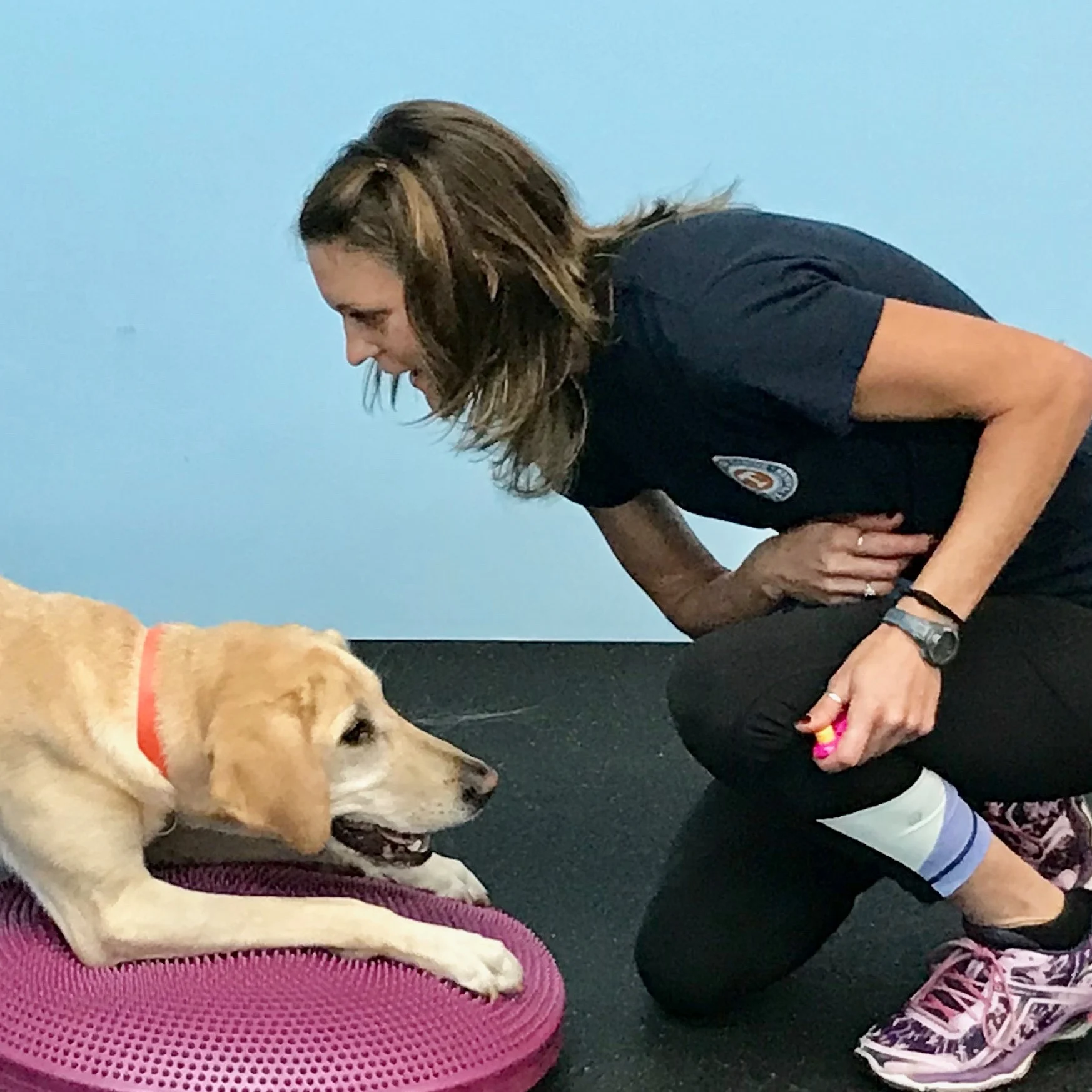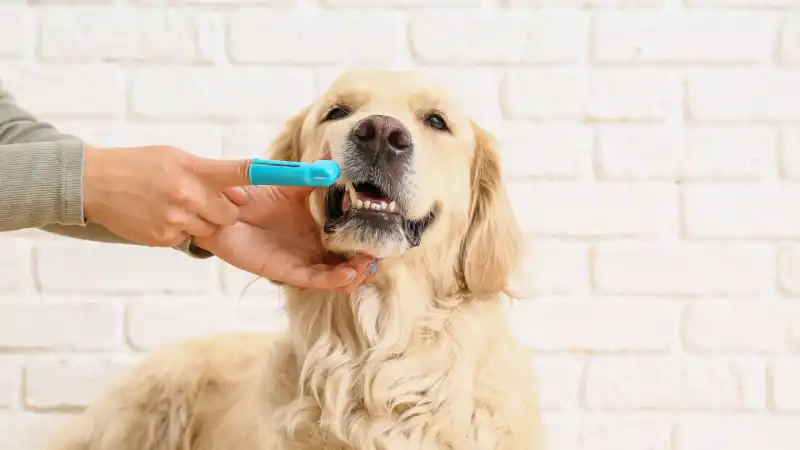Physical Therapy for Dogs FAQ
Learn about physical therapy for dogs from dog rehab experts and therapists. Check out how physical therapy can improve your pet's quality of life.

You may have gone to physical therapy to help recover from an injury or medical condition. Did you know your pup can benefit from dog physical therapy too? Physical therapy for dogs, also known as “canine rehab” or "dog rehab," has gained quite a bit of popularity in the past several years. It is now recognized just how helpful it can be for dogs with disabilities, hip dysplasia, and sore joints (especially senior dogs).
At AKC Pet Insurance, we know that one of the best ways to learn more about canine physical therapy is to take your questions directly to an industry leader in veterinary rehab. Dr. Barbara Butler provides key information on canine therapy modalities in our Q&A interview.
Dr. Butler leads the veterinary rehabilitation program for elderly dogs, disabled dogs, and those that have been injured at Peak Pet Performance at Care First Animal Hospital in Raleigh, North Carolina. Dr. Butler graduated from NC State College of Veterinary Medicine, obtained her Certified Veterinary Acupuncturist (CVA) certification from the Chi Institute of Chinese Medicine, and is also a Certified Canine Rehabilitation Therapist (CCRT). She and her family own, hunt, and compete with their four English Setters.
What types of alternative therapies are commonly used?
Dr. Butler: Acupuncture and electrostimulation (e-stim), hydrotherapy (water treadmill), land treadmill, range of motion exercises, laser therapy, massage, heat and cold therapy, and joint mobilization.
What's your favorite treatment to administer and why?
Dr. Butler: My two favorite treatments are acupuncture and water treadmill. Acupuncture benefits everyone and does not have side effects. Water treadmill rebuilds muscle mass, and the warm water helps relieve soreness and loosen up the muscles.
What are the benefits of getting therapy?
Dr. Butler: Benefits include decreased pain, faster recovery, and improved strength, flexibility, endurance, and function. Some dogs do not do well with medication or have maxed out on which medications they can use. Thus, the dogs need to explore other methods, or modalities, to feel better.
Another benefit is to make your dog’s transition to rehab smoother in the post-surgery period. “Pre-hab” is rehab before your dog’s surgery and may start approximately six weeks prior to surgery. For example, some dogs will come to “pre-hab” to learn the exercises and how to walk on the water treadmill before surgery. In addition, some dogs need to get stronger before surgery, or they may benefit from weight loss before a procedure. Additionally, your dog may recover quicker post-surgery if they’re closer to an ideal weight and aren’t burdening their body with extra pounds.
What are the most common medical conditions that you help treat and heal with these therapies?
Dr. Butler: In our practice, we most commonly see geriatric dogs (those over the age of five in most breeds) with arthritis and neurologic conditions. We also treat dogs that are recovering from back surgeries and knee surgeries.
What are some of the less common medical conditions, surgeries, or ailments that you treat for canines?
Dr. Butler: We have seen several dogs with fibrocartilaginous embolism (FCE), which is essentially a stroke in the spinal cord. We have also seen one dog that had immune-mediated disease in both of her knees. I have also treated patients with cerebellar disease.
How do you determine which therapies to use for a dog?
Dr. Butler: Every patient is different and has unique needs. Laser is a wonderful therapy, but it is not appropriate for puppies or dogs that have had certain types of cancer. We base the recommended exercises on which muscle groups need to be strengthened or stretched. Some types of exercises are too strenuous for geriatric dogs, so we pick less difficult exercises.
What determines how many treatments and the frequency of treatments that the dogs need?
Dr. Butler: Post-op patients often start one to two weeks after surgery and have one or two sessions weekly for 5-10 weeks. Rehab vets work closely with the surgeons to monitor the patient’s progress. Patients with significant muscle loss will need to be treated for a longer period of time. Significant muscle loss can occur with only two weeks of inactivity, but it can take many weeks to rebuild it.
What do you do if a dog will not walk on the land or water treadmill?
Dr. Butler: We have only had a few patients that would not do the water treadmill. In those cases, we will try the land treadmill. If that does not work, then we adjust the in-house therapeutic exercises and home exercises to make up for the lack of treadmill use.
How should owners find a rehab practitioner? What should an owner look for in a provider?
Dr. Butler: Pet owners should talk to their regular veterinarian or surgeon about finding and using a canine rehab provider. In addition to obtaining a referral, owners can review the rehab vet’s credentials, experience, website, treatment packages available, and available equipment. Owners may also search provider listings online for the American Association of Rehabilitation Practitioners (AARV), the Canine Rehabilitation Institute (CRI), and the Certified Canine Rehabilitation Practitioner (CCRP).
Do most rehab drop-off programs require that the dog stays at the facility for multiple hours without the owner? What are the benefits of a drop-off program versus an in-person appointment with the dog?
Dr. Butler: Each rehab practice has its own way of scheduling. Many facilities have a drop-off program, but some schedule the water treadmill and therapy visits as 30-minute or one-hour appointments. Drop-off appointments allow us to use multiple modalities throughout the day, including laser, acupuncture, e-stim, massage, etc., and then allow the pet to rest in between. Scheduled appointments work well for dogs with separation anxiety that do not do well spending the day away from home or their owners.
Do you assign homework exercises or other items, such as administering cold or heat therapy, for the owner to do at home? If so, in what circumstances is there homework?
Dr. Butler:I always recommend homework for my patients. Human physical therapists always send home exercises for their patients, and we find it is also helpful for dogs. The patients that I work with that have owners who are dedicated in doing home exercises always make the best progress.
What do you love most about being a rehab veterinarian?
Dr. Butler: I get so much satisfaction from seeing my patients improve. When I see a patient whose pain has been relieved or whose mobility has been improved, it makes my day! It is also very gratifying to start with a patient who can’t walk and to see them walk again.
What else do you like to tell pet owners about veterinary rehabilitation?
Dr. Butler: If you have a pet that is struggling with arthritis pain or a neurologic disorder, you should seriously consider rehab. It can make a huge difference in your pet’s quality of life. It can also make recovery from back surgery or knee surgery much faster!
If you are concerned that rehab for your dog is too expensive, keep in mind that AKC Pet Insurance (underwritten by Independence American Insurance Company) offers coverage for rehabilitation as long as the condition itself is covered.

Every Dog and Cat Deserves the Pet Insurance of Champions
Get prize-winning care for your pets.

Jasey Day holds the Certified Canine Fitness Trainer (CCFT) credential through the University of Tennessee. She is a member of the Bobbie Lyons K9FITteam - a team of compassionate canine fitness instructors who actively teach others and continually expand their own knowledge. Since 2004, Jasey has taught a variety of workshops and classes on the following: Puppy, Canine Good Citizen/Family Pet, Advanced Family Pet, Canine Fitness, Canine Swimming, Rally, and Agility. In addition, Jasey has earned over 60 titles in Dock Diving, Agility, Rally, CGC and Trick Dog. Jasey has worked full time for the American Kennel Club since 2007 and teaches at Care First Animal Hospital in Raleigh, NC. Jasey’s Labrador Retrievers spend their free time hiking, training, and snuggling with Jasey.
READ MORE ARTICLES

